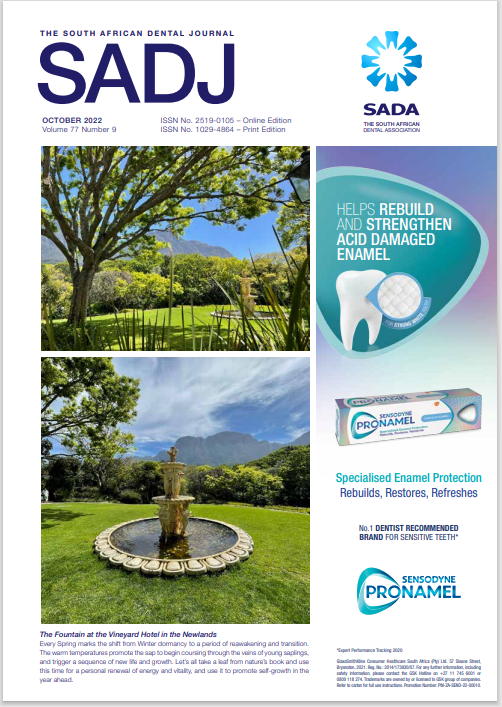Self-reported substance use, in dental and oral hygiene students at a university in South Africa
DOI:
https://doi.org/10.17159/2519-0105/2022/v77no9a2Keywords:
Stimulant drugs, methylphenidate, stress, academic performance.Abstract
A recent study amongst South African dental students found that a number of them had perceived moderate to severe stress and as a result, some have resorted to stimulant drugs. The aim of the study was to assess substance use by dental and oral hygiene students at a university in South Africa. A cross-sectional design was used and all dental and oral hygiene students registered in 2019 at a university in South Africa were asked to participate. Materials and Methods A pretested, validated self-administered questionnaire
was used to achieve the aim. The objectives were to identify which substances were used, where they were obtained, frequency and reasons for use, as well as the self-perceived benefits and side effects experienced. Data was analysed using SPSS version 27. The data
was confidential and anonymity was ensured. A total of 303 (88%) agreed to participate with ages from 17 to 36 years and a mean of 22.3 years. Over two thirds 206 (67.9%) used substances. Almost half of the group (44.6%) took one product, 16.5% took two, and 7%
consumed between 3 and 5. The sources of substances ranged from peers, friends, acquaintances and pharmacies. Nearly twenty percent of the students used caffeine products, energy drinks, and methylphenidate. Almost 10% used anti-anxiety pills and anti-depressants whilst just above 11% used natural boosters and multivitamins. More than half of the students used the substances to stay awake and improve marks and 45(22%) of the users struggled to stop. Conclusions Over two thirds of students used substances, with almost half using one substance. There were multiple sources of substances. More than half of the students used them to stay awake and improve marks.
Downloads
References
Jain R, Chang CC, Koto M, Geldenhuys A, Nichol R, Joubert G. Non-medical use of methylphenidate among medical students of the University of the Free State. South African Journal of Psychiatry. 2017; 23(1).
Jiménez-Ortiz JL, Islas-Valle RM, Jiménez-Ortiz JD, Pérez-Lizárraga E, Hernández-García ME, González Salazar F. Emotional exhaustion, burnout, and perceived stress in dental students. Journal of International Medical Research. 2019 Sep;47(9):4251-9.
Alhajj MN, Khader Y, Murad AH, Celebic A, Halboub E, Márquez JR, Macizo CC, Khan S, Basnet BB, Makzoumé JE, de Sousa‐Neto MD. Perceived sources of stress amongst dental students: A multicountry study. European Journal of Dental Education. 2018 Nov;22(4):258-71.
Collin V, O’Selmo E, Whitehead P. Stress, psychological distress, burnout and perfectionism in UK dental students. British Dental Journal. 2020 Nov;229(9):605-14.5. Abbasi S, Mubeen N, Ayub T, Khan M, Abbasi Z, Baig N. Comparison of stress levels among medical and
dental students in the clinical years of training and their coping strategies. J. Pak. Med. Assoc. 2020 Jun 1;70(1).
Bhayat A, Madiba TK. The self-perceived sources of stress among dental students at a South African Dental School and their methods of coping. South African Dental Journal. 2017 Feb; 72(1):6-10.
Marais A, Steenkamp V, Kok E. The use of methylphenidate as a cognitive enhancer by health sciences students at a South African university:-a pilot study. International journal of Nursing Didactics. 2017 Jul 31; 7(7):31-5.
Massey A. Legalities of trading Concerta and Ritalin. Perdeby. 6 May 2019. Accessed on https://pdby.co.za/legalities-of-trading-concerta-and-ritalin/
Drug and Drug Trafficking Act. No. 140 of 1992. Part II. Accessed on http://www.justice.gov.za/legislation/acts/1992-140.pdf
Leonard BE, Mc Cartan D, White J, King DJ. Methylphenidate: a review of its neuropharmacological, neuropsychological and adverse clinical effects. Human Psychopharmacology: Clinical and Experimental. 2004 Apr; 19(3):151-80.
Vastag B. Pay attention: Ritalin acts much like cocaine. Jama. 2001 Aug 22; 286(8):905-6.
Shellenberg TP, Stoops WW, Lile JA, Rush CR. An update on the clinical pharmacology of methylphenidate: therapeutic efficacy, abuse potential and future considerations. Expert Review of Clinical Pharmacology. 2020 Aug 2;13(8):825-33.
Summit AG, Noel NE. Assessing motivations and gender as factors in college students’ views of nonmedical prescription stimulant use. Journal of American College Health. 2021 Jun 15:1-7.
Beyer C, Staunton C, Moodley K. The implications of Methylphenidate use by healthy medical students and doctors in South Africa. BMC medical ethics. 2014 Dec; 15(1):20.
Mama Y, Icht M. Production effect in adults with ADHD with and without methylphenidate (MPH): vocalization improves verbal learning. Journal of the International Neuropsychological Society. 2019 Feb;25(2):230-5
Kotagal S. Treatment of narcolepsy and other organic hypersomnias in children. Paediatric Respiratory Reviews. 2018 Jan 1;25:19-24.
Esposito M, Cocimano G, Ministrieri F, Rosi GL, Nunno ND, Messina G, Sessa F, Salerno M. Smart drugs and neuroenhancement: What do we know. Front. Biosci. 2021 Aug 30;26:347-59.
Javed N, Ahmed F, Saeed S, Amir R, Khan H, Iqbal SP. Prevalence of Methylphenidate Misuse in Medical Colleges in Pakistan: A Cross-sectional Study. Cureus. 2019 Oct 9;11(10).
Tamminga HG, Reneman L, Schrantee A, Bottelier MA, Bouziane C, Geurts HM, Groenman AP. Do effects of methylphenidate on cognitive performance last beyond treatment? A randomized placebocontrolled trial in boys and men with ADHD. European Neuropsychopharmacology. 2021 May 1;46:1-3.
Mc Niel AD, Muzzin KB, DeWald JP, McCann AL, Schneiderman ED, Scofield J, Campbell PR. The nonmedical use of prescription stimulants among dental and dental hygiene students. Journal of Dental Education. 2011 Mar 1; 75(3): 365-76.
Downloads
Published
Issue
Section
License

This work is licensed under a Creative Commons Attribution-NonCommercial 4.0 International License.






.png)